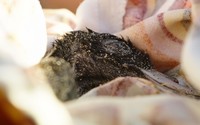Seabirds found with more than 250 pieces of plastic lodged in their stomachs
The Telegraph - Scientists examining the devastating impact plastics are having on the world's oceans have identified seabirds with more than 250 man made objects lodged in their stomachs.
 From bottle tops to pen lids, the flesh footed shearwaters are thought to consume more plastic than any other marine animal.
From bottle tops to pen lids, the flesh footed shearwaters are thought to consume more plastic than any other marine animal.
Often mistaking plastic objects floating in the sea for food, the adult birds pick them up and then feed them to their young, with disastrous consequences.
Researchers working on Lord Howe island, off the coast of Australia, where the flesh footed shearwaters nest, claim that on average every chick has between 30 and 40 pieces of jagged plastic in their stomachs before they are fully fledged.
But in one case scientists found a young bird with 260 separate items of plastic stuck in its gut.
Even if the seabirds survive to leave the nest, the weight of the plastic resting in their stomach, means they are often too heavy to take off and many drown in the surf around the island.
The shocking impact that pollution is having on the sheerwater population is revealed in a BBC documentary, Drowning in Plastic, which is being broadcast a year on from the landmark Blue Planet II series.
Presented by Sir David Attenborough, Blue Planet II, was credited with raising international awareness of the threat posed by plastic pollution.
It was also thought to be responsible for The Queen’s decision to ban plastic bottles and straws from the Royal estates.
In this latest BBC film, wildlife biologist, Liz Bonnin travels around the world to highlight the growing crisis facing the marine environment.
She visits a group of scientists who have spent the last 12 years examining the world's largest colony of flesh footed shearwaters in the Tasman Sea.
Around 40,000 birds migrate to Lord Howe island each year to lay their eggs in burrows deep inside the rainforest.
Researchers believe the birds consume more plastic than any other marine animal, the equivalent of a human eating around 10 kilograms.


